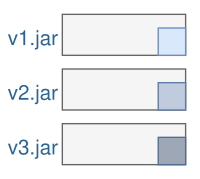
Putting a fat jar into a Docker container is a waste of storage, bandwidth and time. Fortunately, we can leverage Docker’s image layering and registry caching to create incremental builds and very small artifacts. For instance, we could reduce the effective size of new artifacts from 75 MB to only one MB! And the best is that there is a plugin for Maven and Gradle handling everything for us.

Since Vaadin 10, SASS is no longer supported out of the box. Fortunately, it’s really easy to integrate SASS in a Vaadin 10+ app and its Maven build. But how can we ensure a fast feedback cycle during the SASS development? Restarting the app is cumbersome. Even a page reload would reset the UI state, which leads to annoying clicking through the app. Luckily, there is an approach that automatically exchanges the changed CSS without any browser refresh or app restart.

“Maven is old school” they said. “Use Gradle instead. It’s the future of building Java applications” they said. Sounds like something you don’t want to miss. So I tried Gradle in two real-world projects. In this post, I like to tell you about my experiences with Gradle and why I finally migrated back to Maven. It’s a story about enthusiasm and disillusionment.

At a first glance, in-memory databases (like H2 or Fongo) look like a good idea. You can test your code without having to worry about installing and managing a dedicated database server up front. Just start your tests and the H2 database will be up and running. However, this comfort comes with severe drawbacks. In this post, I explain my reservations and point out Docker as an alternative which can be easily used with TestContainers or within the Gradle/Maven build.

Dealing with version numbers is an important challenge on the way to Continuous Delivery. The classical versioning approach (“8.2.0”) and release workflow is inappropriate, because it can’t be automated properly. This post shows how we can leverage the Git commit hash to get rid of manual workflows and automate the Continuous Delivery pipeline. At the end, every build will produce an artifact which is potentially shippable. We’ll implement this solution with Maven and Docker.

Introducing Continuous Delivery means to automate the delivery process and to release our application frequently. This way, we improve the reliability of the release process, reduce the risk and get feedback faster. However, setting up a Continuous Delivery pipeline can be difficult in the beginning. In this step by step tutorial I will show you how to configure a simple Continuous Delivery pipeline using Git, Docker, Maven and Jenkins.

Dropwizard produces a fat jar containing every dependency your microservice needs to run. This includes a web server. This way, no web server needs to be installed and configured on the target machine. However, there is some infrastructure left (like the JRE) which still has to be installed before the deployment. That’s where Docker enters the stage. With Docker we can produce an artifact containing really everything we need to run our microservice. In this post, we take a look at how we can integrate Docker into our Maven build, run our tests against the container and push the image to a repository.






